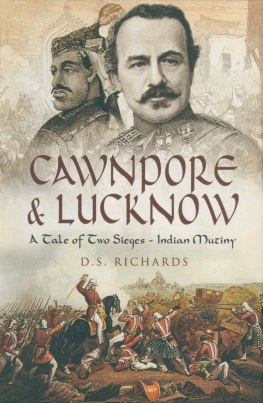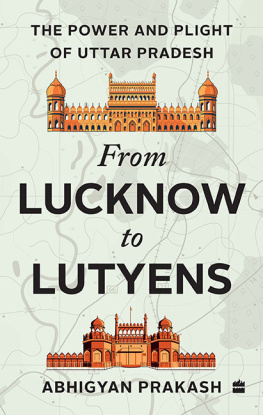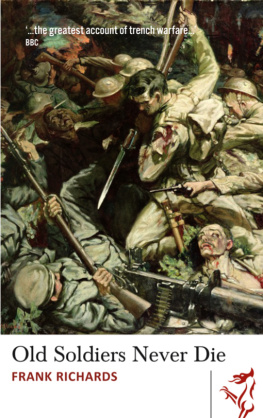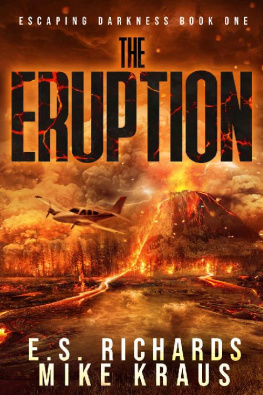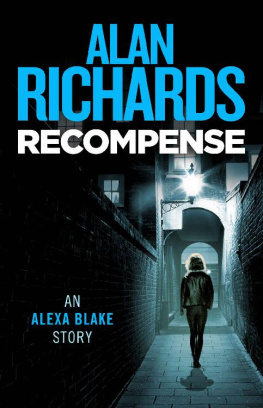D. S. Richards - Cawnpore and Lucknow
Here you can read online D. S. Richards - Cawnpore and Lucknow full text of the book (entire story) in english for free. Download pdf and epub, get meaning, cover and reviews about this ebook. year: 2007, publisher: Pen & Swords, genre: Home and family. Description of the work, (preface) as well as reviews are available. Best literature library LitArk.com created for fans of good reading and offers a wide selection of genres:
Romance novel
Science fiction
Adventure
Detective
Science
History
Home and family
Prose
Art
Politics
Computer
Non-fiction
Religion
Business
Children
Humor
Choose a favorite category and find really read worthwhile books. Enjoy immersion in the world of imagination, feel the emotions of the characters or learn something new for yourself, make an fascinating discovery.
- Book:Cawnpore and Lucknow
- Author:
- Publisher:Pen & Swords
- Genre:
- Year:2007
- Rating:3 / 5
- Favourites:Add to favourites
- Your mark:
- 60
- 1
- 2
- 3
- 4
- 5
Cawnpore and Lucknow: summary, description and annotation
We offer to read an annotation, description, summary or preface (depends on what the author of the book "Cawnpore and Lucknow" wrote himself). If you haven't found the necessary information about the book — write in the comments, we will try to find it.
Cawnpore and Lucknow — read online for free the complete book (whole text) full work
Below is the text of the book, divided by pages. System saving the place of the last page read, allows you to conveniently read the book "Cawnpore and Lucknow" online for free, without having to search again every time where you left off. Put a bookmark, and you can go to the page where you finished reading at any time.
Font size:
Interval:
Bookmark:
CAWNPORE
AND
LUCKNOW
For my wife, Nancy
CAWNPORE
AND
LUCKNOW
A Tale of Two Sieges
D.S. Richards

First published in Great Britain in 2007 by
PEN & SWORD MILITARY
an imprint of
Pen & Sword Books Ltd
47 Church Street
Barnsley
South Yorkshire
S70 2AS
Copyright D.S. Richards, 2007
ISBN 1-84415-516-1
The right of D.S. Richards to be identified as the author of this work
has been asserted by him in accordance with the Copyright, Designs
and Patents Act 1988.
A CIP catalogue record for this book is
available from the British Library
All rights reserved. No part of this book may be reproduced or transmitted in any
form or by any means, electronic or mechanical including photocopying, recording
or by any information storage and retrieval system, without permission from the
Publisher in writing.
Typeset in 11/13 Sabon by Concept, Huddersfield, West Yorkshire
Printed and bound in England by Biddies Ltd
Pen & Sword Books Ltd incorporates the Imprints of
Pen & Sword Aviation, Pen & Sword Maritime, Pen & Sword Military,
Wharncliffe Local History, Pen & Sword Select,
Pen & Sword Military Classics and Leo Cooper
For a complete list of Pen & Sword titles please contact
PEN & SWORD BOOKS LIMITED
47 Church Street, Barnsley, South Yorkshire, S70 2AS, England
E-mail: enquiries@pen-and-sword.co.uk
Website: www.pen-and-sword.co.uk
CONTENTS
| Lieutenant Gordon Alexander | 93rd of Foot |
| Captain R.F. Anderson | 25th NI |
| Captain George Atkinson | 6th NI |
| Mrs Katherine Mary Bartrum | |
| Major G.W.F. Bingham | 64th of Foot |
| Ensign George Blake | 84th of Foot |
| Mrs Corlina Maxwell Brydon | |
| Lady Charlotte Stuart Canning | |
| Mrs Adelaide Case | |
| Nanak Chand | Bankers Agent |
| Lieutenant Henry George Delafosse | 53rd NI |
| Mrs Emma Sophia Ewart | |
| Colonel John Alexander Ewart | 1st NI |
| Corporal William Forbes-Mitchell | 93rd of Foot |
| Mrs Maria Vincent Germon | |
| Cornet Hugh Gough | 3rd Light Cavalry |
| Lieutenant William Groom | Madras Fusiliers |
| Mrs Georgina Maria Harris | |
| Mrs Lydia Hillersdon | |
| Miss Amelia Horne | |
| Mrs G. Huxham | |
| Lady The Hon. Julia Inglis | |
| Mr John Lang | Barrister |
| Miss Alice Lindsay | |
| Miss Caroline Lindsay | |
| Miss Fanny Lindsay | |
| Mrs Kate Lindsay | |
| Lieutenant Vivian Dering Majendie | Royal Artillery |
| Captain John Francis Maude VC | Royal Artillery |
| Corporal Henry Metcalfe | 32nd of Foot |
| Lieutenant Henry Martin Moorsom | Rifle Brigade |
| Surgeon William Munro | 93rd of Foot |
| Major Charles North | 60th Rifles |
| Subedar Sita Ram Pande | Bengal Army Pensioner |
| Ensign Hugh Pearson | 84th of Foot |
| Mr L.E.R. Rees | Calcutta Merchant |
| Lieutenant Frederick Sleigh Roberts | |
| VC | Bengal Horse Artillery |
| Ensign J. Ruggles | 41st NI |
| Mr William Howard Russell | The Times Correspondent |
| Mr William Jonah Shepherd | Head Clerk, Commissariat |
| Mr John Sherer | Magistrate and Collector |
| Sergeant Ludlow Smith | 48th NI |
| Mrs Elizabeth Sneyd | |
| Mr William Oliver Swanston | Civilian Volunteer |
| Lieutenant Mowbray Thomson | 53rd NI |
| Cadet Edward Spencer Watson | HMS Shannon |
On the last day of December 1600, Elizabeth I granted the Company and Merchants of London trading with east India a charter enabling them to conduct business in gems, indigo, camphor and spices. Twelve years later, with the permission of the Moghul Emperor Jahangir, they were then able to set up a permanent trading post at Surat on the west coast. Thus Britain set foot in India as merchants and until the late eighteenth century the East India Company was content to prosper by sea and in quiet trade. The French had also established a number of trading stations in India, notably at Pondicherry and at Chandernagor in Bengal, and until 1730 relations between the two rival companies were reasonably peaceful. Later, increasing tension between France and England in Europe persuaded the French East India Company to enlist native soldiers to protect their interests. John Company was quick to respond by raising a similar army and when war came, Robert Clive gained an impressive victory at Plassey in June 1757 over the combined forces of the French and the Nawab of Bengal, Suraj-ud-daula, and established the East India Company as the principal trader on the subcontinent.
During the latter half of the century the East India Company, with the support of the British Government, extended its power and influence by assuming responsibility for the armies of the three presidencies of Bengal, Madras and Bombay. They were largely composed of native infantrymen or sepoys, and by cavalrymen known as sowars. Each regiment had its complement of native officers or jemadar, a rank equal to lieutenant, but all were subordinate to the most junior of British officers in the native regiments and were not even allowed to give orders to a British sergeant major. In addition to the Companys native regiments, there were also British Army regiments stationed in India, but by 1856 the ratio of British soldiers to Indian, was no better than one in six.
To the north-west of Bengal lay the Moghul kingdom of Oudh which had yet to feel the full impact of British rule, whilst further south, although the predominately Muslim faction had been brought under control, people nevertheless harboured a sullen resentment of the British. The many religions of India, together with the caste system, puzzled and appalled the average Englishman. The majority of Indians were Hindus and the caste system governed their entire social and emotional behaviour unlike Islam whose followers embraced the Koran and looked upon Allah as being all powerful.
It is perhaps not easy 150 years on to appreciate that the political, social and economic welfare of some 250 million souls was supervised by a few hundred young English administrators supported by less than 13,000 British troops. The precariousness of such an administration was recognized at the time by a few discerning individuals such as Sir Charles Metcalfe who wrote: Our domination of India is by conquest; it is naturally disgusting to the inhabitants and can only be maintained by military force. It is our positive duty to render them justice, protect their rights, and to study their happiness. It was a difficult balance to maintain in the face of widespread resentment, and John Sherer, a magistrate in Cawnpore, had no doubt as to the malign influence the Brahmins had on the Hindu soldiers. The Brahmins have always been the inimical force which is discontented with British supremacy, he wrote. Not because it is British, but because it is Western because the political principles of the West are all opposed to any belief in caste that is, caste as understood in India.
Next pageFont size:
Interval:
Bookmark:
Similar books «Cawnpore and Lucknow»
Look at similar books to Cawnpore and Lucknow. We have selected literature similar in name and meaning in the hope of providing readers with more options to find new, interesting, not yet read works.
Discussion, reviews of the book Cawnpore and Lucknow and just readers' own opinions. Leave your comments, write what you think about the work, its meaning or the main characters. Specify what exactly you liked and what you didn't like, and why you think so.

